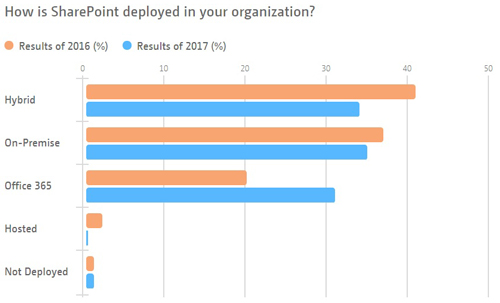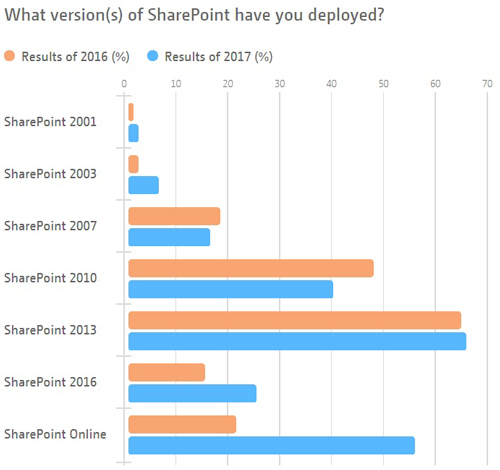Survey: SharePoint Users Crowd the Cloud Onramp
Microsoft SharePoint users surged into cloud deployments in 2017, according to a new survey.
"The SharePoint and Office 365 Industry Survey" released this week by SharePoint tools suppliers Sharegate, Hyperfish and Nintex included responses from about 450 IT professionals and SharePoint administrators. What makes the survey interesting is that the same three companies surveyed a random sample of their combined client pools in 2016, as well, providing lots of data points for comparison.
There was a triple-digit increase -- 167 percent -- in SharePoint Online deployments from 2016 to 2017. While only 21 percent of respondents in 2016 had SharePoint Online deployed, that number soared to 56 percent in 2017. Even though that means that more than half of companies had SharePoint Online deployed, a lot of them were also still running on-premise SharePoint deployments in parallel.
Yet another data point in the survey shows more and more users trusting their entire SharePoint workload to the cloud. In 2016, one-fifth of users had SharePoint deployed exclusively online. A year later, that number was nearly a third (31 percent). At the same time, hybrid environments (a mix of SharePoint Online and on-premises SharePoint deployments) dropped by 7 percentage points to 34 percent and on-premises-only environments dropped by 2 percentage points to 35 percent in 2017.

The shift to the cloud in SharePoint is mirrored on the Active Directory (AD) side in the vendor survey. In 2016, a very slight majority of AD deployments involved on-premises AD (51 percent). But in 2017, that number fell to 42 percent, while a mix of on-premises and Azure AD jumped 3 percentage points to 34 percent and pure Azure AD deployments rose 4 percentage points to 16 percent.
The survey also reveals the relative share of the last six on-premises versions of SharePoint, dating all the way back to SharePoint 2001, although that version and SharePoint 2003 are present in low enough numbers to make any conclusions about the trends on those editions statistically questionable.
Among the newer versions, the only one gaining significant share is the most recent, SharePoint 2016, which saw a 67 percent increase in deployments from 2016 to 2017. While impressive, it's gaining share at a much lower rate than SharePoint Online/Office 365 and from a smaller base. SharePoint 2016 ended 2017 with a presence in 25 percent of respondents' shops.
Holding steady and maintaining the largest share of any edition, including SharePoint Online, is SharePoint 2013. Deployed at 66 percent of respondents' sites, SharePoint 2013 won't maintain its lead through 2018 if SharePoint Online continues its momentum.

For 2017, SharePoint Online seemed to be taking most of its share from SharePoint 2007, which dropped 2 percentage points to 18 percent, and especially from SharePoint 2010, which dropped 8 percentage points to 40 percent.
As Office 365 deployments continue to gallop ahead, there is little reason to suspect that SharePoint Online's share of overall SharePoint workloads won't continue to increase. The question is how fast.
As befits a survey fielded by tools vendors, a statement accompanying the data points out that obstacles remain for those still moving to SharePoint Online.
"The move to the cloud is not always as easy as it sounds. Microsoft has released a content migration tool to help customers leave SharePoint 2010 and 2013, but it just isn't enough. Here at Sharegate, we still see a large number of customers leveraging our tools to migrate while keeping their existing site structure and objects," said Benjamin Niaulin, Microsoft Regional Director & Product Advisor at Sharegate.
Among the challenges are ongoing concerns about security, cost constraints, time constraints and difficulties in migrating SharePoint customizations from on-premises to online.
This survey says progress to the cloud in 2017 was rapid. The question for 2018 will be whether that pace can continue. Were we looking at low-hanging fruit, easy wins and pilot projects that could stall slightly this year? Or was it an early majority shift that could bring nearly half of the SharePoint customer base exclusively into the cloud by year's end?
Posted by Scott Bekker on 01/10/2018